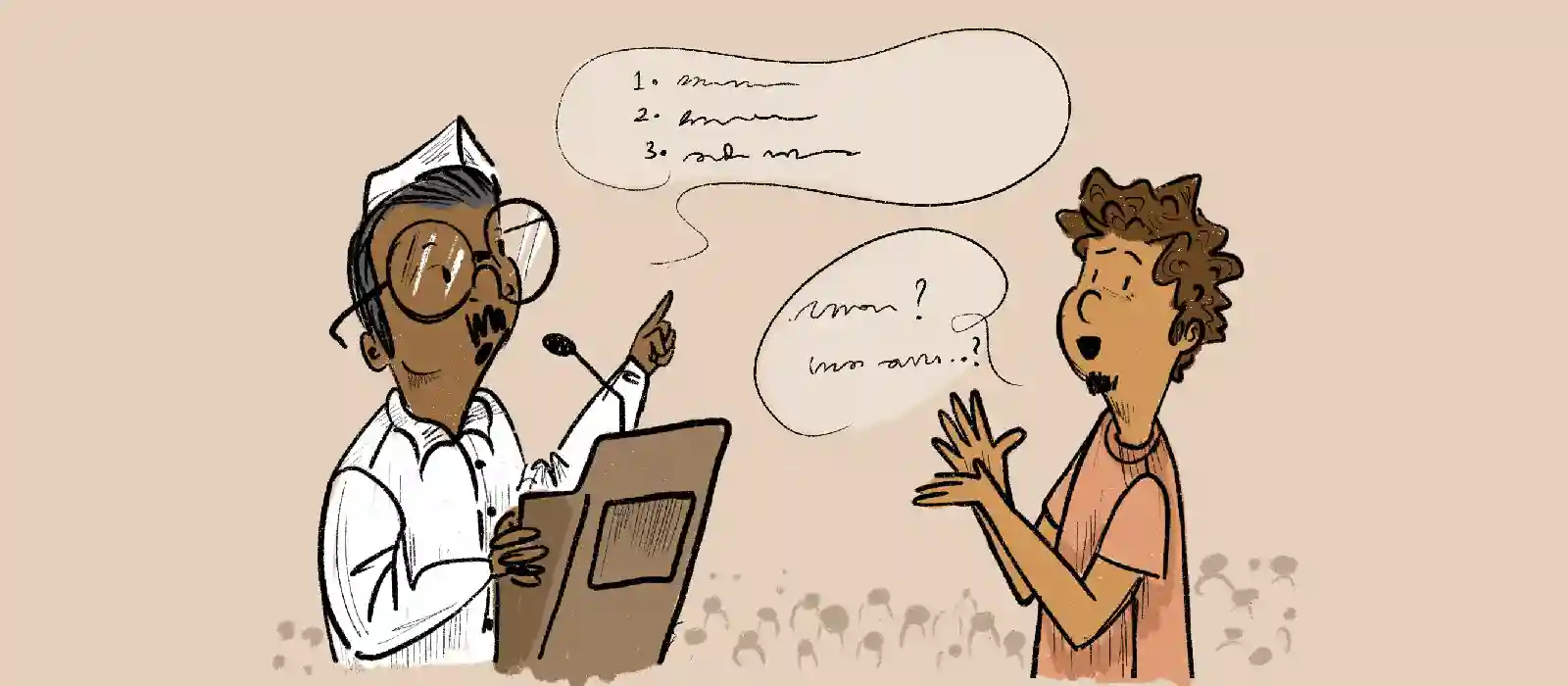UX UI Design Studio



In a democracy, with a population of over a billion people, there are countless problems that exist. For years, politicians have been at the receiving end of reproach and mistrust – and blame cannot be placed solely on the shoulders of one party. Perhaps, we just need to rethink the approaches that we take to find solutions. We believe that it is possible to change how we perceive politics & politicians and design ‘solution-driven interactive systems’ that involve inputs from politicians, designers and the population at large.
Unlike any other corporate systems, politics also have been focusing on problems and not the users, rendering it unusable, ambiguous and far from the actual needs of the citizens.
Before beginning to discuss how design can bridge the gap between the needs and pain points of the citizens, let’s first understand each role and the responsibilities associated with them.
A politician is someone who actively participates in politics and holds an elected office. The main role of a politician is to serve the best interests of the people of the nation. Politicians bridge the gap between the government and the public by forming policies and creating programmes that cater to the people. When politicians that have similar beliefs and procedural agendas come together, they form a political party.
Politicians are in charge of creating policies, proposing changes, and initiating the process to amend laws. They are usually in charge of solving internal matters of the country, by understanding what the people themselves want. Their role as enactors of state policy is vast and comprises a wide range of sectors including defense, education, agriculture, trade, taxation, and so on. They also look into resolving conflicts, making provisions after natural calamities, looking into the welfare of women and children, and so on. It is evident that the role of a politician is extremely vast and important for the functioning of a country.
An Experience designer is a solution strategist; they bridge the gap between the users and solution providers. They are responsible for understanding the pain points of actual users and design solutions that solve these problems in the best possible manner. They are also responsible for understanding the vision and goals of the solution providers and bridge the gap between both the entities. Designers of every field provide the foundation for great products or features that avoid assumptions and make information-driven decisions. What makes designers unique is their ability to put users at the heart of the solutions.
Essentially, the public comprises the entire population of a country. The government’s services are for the people and by the people, and the people themselves are the users of the services being provided.
The main problem today is that politicians seem to be obsessed with finding answers and solutions; they are solution-centric and probably not people-centric. For example, demonetization might have been a great solution for doing away with the black money but was it people-centric? The answer is probably no, or was it a yes? If you think the answer is a no then the core reason might be the huge communication gap between the politician and people. In order for politicians to stay true to their responsibilities and serve us better, their process needs to put the users at the forefront of all operations.
A true democracy functions on the principle of ‘By the people, for the people, of the people’, and revisiting this principle can probably help the nation and its political leaders. Designers can play a crucial role here, with their design thinking ability.
Design thinking, as many of us might be aware of, is a research and data-driven approach to identifying a problem, the people it affects, exploring solutions and constantly working on integration and improvisation of the solutions, with the help of the stakeholders’ healthy involvement. Design thinking involves numerous steps that aim at assessing and designing solutions that soothe the pain points of a user. These steps are:
When taking a major decision, the first step is to identify the target audience and interact with them closely to understand them. It is crucial when building a rapport with the end user, to be able to understand their problems, what they need, and how we can solve them. When in the discovery phase, one aims to understand what truly matters to users and the decision makers.
Once a problem area has been discovered, the next step is to give it a concrete form. This concrete form is a well-defined problem area that is backed with statistical data from the previous step. Defining the problem allows a designer to plan the direction in which the design is headed, so as to solve the problem.
It is important to note that sometimes there might be multiple solutions to the same design problem, but for the purpose of picking the right solution, the stakeholders play a crucial role. The right balance between existing systems and ideal ones needs to be achieved. The result of such a balance is the ideation of design that meets the needs of all the concerned audiences.
Picking the right solution is certainly a difficult task, and implementing it comes with its own challenges! Human behavior is rather diabolical – unpredictable and dynamic. Quick changes in human tastes, preferences, and behavior, give rise to the need for a solution that is efficient and updateable. The best solutions are usually a result of a sturdy combination of research and iteration. Iterations need to be watched keenly so as to identify any potential or existing problems the instant they become visible. Once identified, the problems need to be treated carefully.
The above process elaborates how designers can ensure holistic action and this can definitely aid politicians in fulfilling their duty towards the nation and its people. If implemented well, we can perhaps hope to bring about more seamless governance by incorporating design thinking in government functioning.
The following areas show massive scope for strong, targeted efforts and quick responses, so as to include design in politics:
Very often, the identified problem areas are within the scope of a politician’s responsibilities; and hence it’s crucial that politicians understand the people and their pain points. However, there is a huge communication gap. Of course, nobody expects politicians to interact with people personally, considering they have a lot of responsibilities to fulfill; this is where designers come in. By creating spaces and forums for people to voice what bothers them, politicians can get accurate insights into people’s heads and their problems.
Maybe we can look at designing an app, a website, or a forum in a way that allows for problems to be categorized according to different states or zones. Analyzing data from such forums will allow for the most pervasive problems to come to the forefront, and give an overview of the proposed solution from the perspective of the people themselves. Moreover, it will also be possible for the collected data to communicate the challenges and timelines, at the governmental level. When a politician finishes a task, it can be directly reflected in his/her profile.
This can be elaborated with an example: One of the most common daily hassles is that of traffic. Everyone needs this problem to be solved – maybe the residents of Bangalore need it more than those of Mumbai. An interface like the one mentioned above can allow for people to post their comments and feedback about the traffic problem. The government can look into and communicate their plan towards resolving these issues, with the help of infrastructural developments, and associated challenges and steps to bypass these challenges. A possible plan that the government could come up with to ease traffic woes would be to reduce vehicle ownership by increasing taxes on imported vehicles. And taxation could vary at the state level. Reduced ownership will mean that there will be an increase in the users of public transportation facilities. To ensure a smooth experience, the condition and accessibility of public transport have to be improved. Similarly, there can be many possible findings and solutions.
Clear, transparent communication will increase the ownership of the government, and the confidence of the public at large. Designers can certainly help create a system that can ensure the same, by working towards a strong UX strategy.
What we perceive as what politicians serve today, looks quite chaotic, and it is! This is probably why a huge chunk of the population gets scared by the mere thought of anything that involves government paperwork, whether it is for the sake of getting a passport, a voter ID or even the Aadhar card updated. Continuous changes in policies and cumbersome procedures make it really difficult for people that already juggle between their personal and professional lives. As already identified, better communication always helps those in service provide better services. Perhaps the need is for a strong, intuitive website, that is structured and informative. This leads a person to a specific subdomain that clearly states the complete list of required documents, with an easy upload feature. In case of security reasons, the same documents could be sent to the required authorities. Upon verification, the final document, such as the passport, can be posted to the applicant. The aforementioned serving as a small example, it is evident that designers form guidelines for design during projects, with the help of which it is possible to bring design direction for the government and help in communicating via the right channels. What will essentially be brought about is design for the people, by a blend of the efforts of politicians and designers. This is important so that the user is not left miffed with constant changes. Politicians need to look into removing all possible roadblocks, to make the process as user-friendly and seamless as possible. Using strong and well-guided design direction, the negative feeling induced within a user can be avoided along with a sufficient amount of research about the users, their needs, goals, and problem areas.
A prosperous nation with happy citizens should be the benchmark to showcase good governance. Bhutan measures its economy with the happiness index of its people, which may certainly not be the most appropriate way of functioning, but is definitely a step towards the betterment of the nation. A politician who really wishes to serve the people of the nation should consider reaching out to the people and make processes of the government people-centric. For example, a politician may be able to ask the right questions and look into why there are so many pending court cases that just do not seem to get resolved. A politician may also look into more fundamental issues such as ensuring that basic necessities are available at nominal rates so that even the poor of the nation can at least afford to eat food. The common thread of these two examples is that policies need to be formulated in a way that eases the lives of people by giving them due importance.
As with everything, it is definitely going to be important to improvise upon the solutions duly designed. To ensure that overall the solution provided is robust and adaptable, a continuous feedback loop and usability testing of the solutions is required. Also, a fact-based solution will go a long way, as compared to solutions that are based purely on assumptions by those who hold high positions but have insufficient data. Focus groups can be designed by identifying the possibility of a fusion between UX design and politics, helping politicians understand the receptivity and responsiveness of the people to any proposed project. Finding a data-driven solution can help induce faith in the minds of the people, and consequently work towards a stronger ruling by the government. any measures of good governance.
With the world in a state of constant change, we find it necessary to speak within geographical boundaries. In India, a five-year term for a politician, today, has become almost like a do or die situation. This official term is considered to be the best way for politicians to prove how much they are able to serve the nation and the people. It has never been more important to understand where the people of the nation stand in terms of what they want, than it is today, owing to the high volume of people accessing technology and subsequently all available information. With the explosion of information, it is important for politicians and their respective parties to ensure a transparent and two-sided flow of communication, so as to imbibe trust within the people. This will lead to a situation where the confidence of people in the government is so high that the duration for which a politician stays in office, will not matter. All that will matter is how much a politician at his/her level actually ended up doing for the people. A large amount of confusion would be removed, and it could provide people with a focused approach towards assessing the caliber of the politicians in power. It also implies that a politician will be able to actually be present at the moment, rather than being thought of as hiding away and plotting randomized ideas based on assumptions. If a politician can break through and understand the people, he can revisit the true concept of a democracy, which is, ‘Of the people, by the people, for the people.’
To conclude, we are certain that designers and design thinking can aid the politicians of a nation in working on a people-centric strategy to take care of the nation’s affairs. Granted, there is no easy way of bringing about a change of this sort, owing to the complex, multi-level nature of governments and the political systems involved. However, we are sure that user-centric design in our governance can help politicians reach out to the masses and work on serving the best interests of the people, and work on bringing forth the true meaning of By the people, for the people, and of the people.
